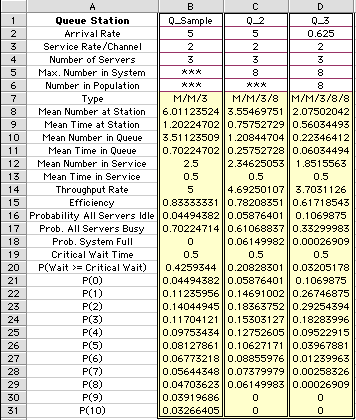|
The column for Q_Sample provides answers
to the questions originally posed. How many machines on the
average will be waiting for repair? This is given by the mean
number in the queue or 3.51. The mean number in service (or
actually being repaired) is 2.50, so the total number in the
system is 6.01. This is an interesting number because it represents
the average inventory due to the maintenance operation.
How much time will a machine spend in
the repair facility? This is given by the mean time in the system
as 1.20 hours. The time dimensions are the same as those assumed
for the arrival and service rates. The system time is broken
into time in the queue (0.70 hours) and time in service (0.50)
hours. These numbers are interesting because they describe the
cycle time for the manufacturing process.
How often will the workers be idle? The
efficiency result indicates that on the average the repair workers
are busy 83.3% of the time. The state probabilities indicate
that all three workers are idle simultaneously 4.5% of the time
(P(0)), all three are busy 70% of the time (1 - P(0) - P(1)
- P(2)), and the system is never full since in this case there
is no limit to the length of the queue.
The columns for Q_2 and Q_3 show the
results for systems with a finite queue and a finite population
respectively. For the finite population case, Q_3, we have entered
an arrival rate for an individual of the population as 0.625.
When the system is empty, every member of the population arrives
at this rate so the total arrival rate is 8*0.625 = 5. Thus,
the third system is comparable to the other two, which also
have arrival rates of 5.
|





